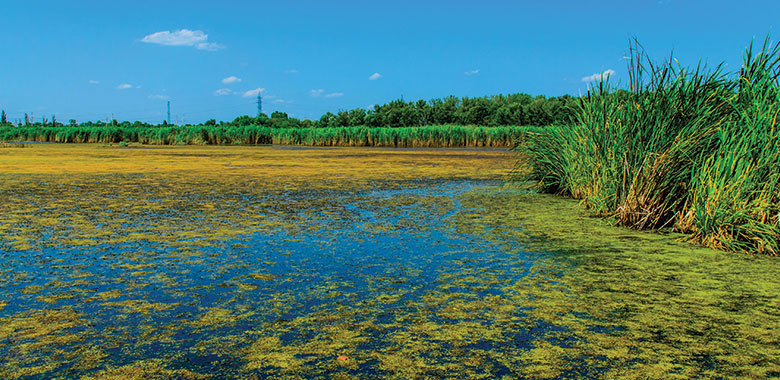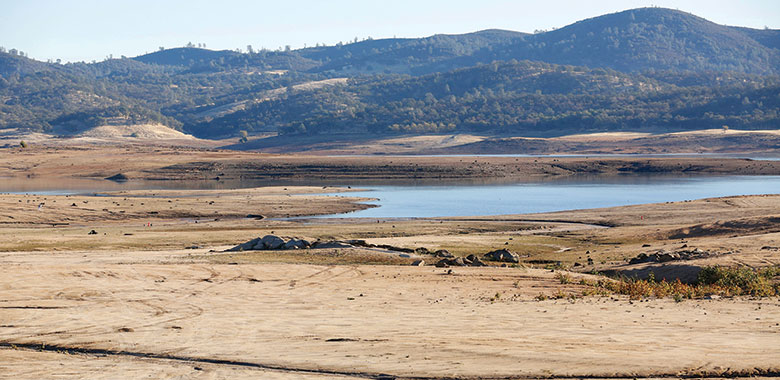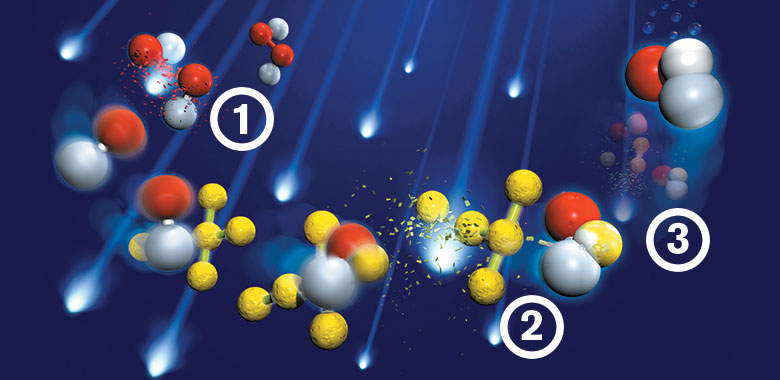The UV advanced oxidation process – also known as UV AOP – is when ultraviolet light, in combination with an oxidant, breaks down environmental contaminants in water. Environmental contaminants are harmful chemicals that may come directly from human sources such as industrial manufacturing, agricultural run-off, or wastewater discharge, or they may originate from natural sources, such as the taste- and odor-causing chemicals generated by algae and bacteria blooms.

Drinking water sources we rely upon every day are increasingly at risk of chemical contamination. Many of these contaminants have been proven harmful or carcinogenic and must be treated and removed in order for the water to be considered useable. UV AOP is a critical step in the process and is currently being used to treat groundwater and surface water for a variety of contaminants including pesticides, algal toxins, nitrosamines (e.g., NDMA) and 1,4-dioxane.
Potable reuse is the process of recycling wastewater for the augmentation of drinking water supplies. UV AOP is a key part of the potable reuse treatment scheme, working alongside microfiltration and reverse osmosis to ensure a high-quality water is produced – water that exceeds the standards for drinking water. The role of UV AOP is to reduce low-molecular-weight contaminants that can pass through RO membranes, such as 1,4-dioxane, NDMA, pharmaceuticals, endocrine disruptor chemicals or industrial solvents.

UV AOP requires UV light and an oxidant, such as hydrogen peroxide or chlorine. The process occurs in the UV chamber instantaneously with oxidizing radicals attacking and decomposing contaminants, so they are no longer harmful.

When UV light is introduced into the water, oxidant molecules absorb the UV light. This converts oxidants into highly energetic and reactive oxidizing radicals.
Oxidizing radicals break down the bonds of contaminant molecules and reduce the potentially harmful chemical to its elemental components.
At the same time, UV light treats the water.
UV-photolysis is a photochemical reaction in which only UV light (without an oxidant) is required to break down a chemical contaminant. The contaminant molecule absorbs the UV light which breaks down its bonds. In most cases UV AOP is required to treat chemical contaminants, but in some cases, as with NDMA, UV-photolysis is all that is required.
Our UV AOP systems can also perform treatment to obtain log reduction credits for microorganisms. This is ideal for water providers needing to meet requirements of the Surface Water Treatment Rule, Long Term 2 (LT2) Enhanced Surface Water Treatment Rule, or the Groundwater Rule, in addition to their contaminant removal needs.
Many other treatment technologies merely transfer the contaminant from one phase to another (e.g. air stripping: from water to air) resulting in a potentially hazardous, contaminant-laden residual that requires further treatment or disposal.
Not all contaminants can be easily removed from water using processes like microfiltration, granular activated carbon or reverse osmosis. For contaminants such as 1,4-dioxane and certain nitrosamines, UV AOP is the only practical and proven solution.
UV AOP occurs instantaneously within the UV chamber, eliminating the need for the large concrete contact basins or steel pipes commonly used in conjunction with ozone. This allows UV AOP systems to be easily retrofitted into existing water treatment facilities.
Have questions? Call us at 1 (888) 220-6118 or complete the form below.
Volatile Organic Compounds
Pesticides
Taste and Odor Causing Compounds
Treatment By-products
Algal Toxins
Explosives
Hazardous Substances
Our renowned team of scientists and researchers have analyzed thousands of water samples from around the world, and our industry-defining UV AOP systems have been installed at treatment plants from California to Australia to treat a wide array of contaminants.
It all starts with a water sample.
We will measure characteristics of your water critical to UV AOP performance – such as UV transmittance, pH, nitrate ion concentration, and radical scavenging – to determine if UV AOP makes sense for your treatment plant.